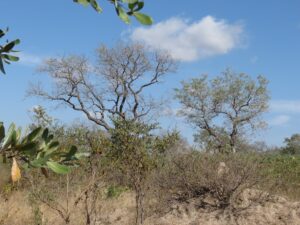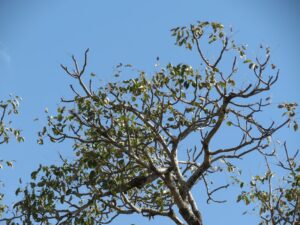Marula
Overview
The Marula, or Sclerocarya birrea, is a resilient subtropical tree renowned for its delicious fruits and nuts. Beloved in cosmetology for its marula oil, this tree is simple to cultivate and supports diverse wildlife. Its fruits, savored by both humans and animals, ripen around March and have roots in African traditions1 2 3 4.

Characteristics
Known for its drought resistance, fast growth, and nutritional fruits often used in beverages and cosmetics.
Region
The Marula plant is native to southern Africa and is found in the subtropical regions of this area.
Natural Habitat
The Marula plant is usually found in the woodlands and savanna regions of sub-Saharan Africa.
Cultivation
Prefers full sun, moderate water, and well-drained, loamy soil.
Uses and Benefits
The Marula tree, Sclerocarya birrea, is a generous provider with a wide range of uses and benefits. Its fruit is not only a delicious snack but also a key ingredient in creating various beverages3. Whether enjoyed fresh or fermented, Marula fruits add a distinct flavor to local dishes.
Beyond its culinary uses, the Marula tree’s oil is a valuable asset in the beauty industry. Extracted from the fruit, this luxurious oil is known for its hydrating properties and lightweight texture, making it ideal for:
- Nourishing and moisturizing skin
- Promoting healthy hair growth and shine
- Strengthening and conditioning nails
The Marula tree’s significance extends further, as various parts of the tree have been integrated into traditional African medicine2. This showcases the tree’s versatility and importance beyond its culinary and cosmetic applications.
In addition to its benefits for humans, the Marula tree also plays a crucial role in supporting local ecosystems. Its strong branches provide shelter and habitat for a diverse array of birds and animals, making it a caring presence for both the environment and the creatures that depend on it.

Cultivation Tips
For those yearning to grow the resilient Marula tree (Sclerocarya birrea), start with a large cutting from an existing tree for a head start on growth1. These fast growers provide both food and shelter for wildlife, maturing into thick-branched safe havens in no time1. Since the Marula doesn’t cast an intense shadow, you’ve got the perfect opportunity to nurture semi shade-loving plants underneath its canopy1.
When planning your Marula garden, keep these tips in mind:
- Include female trees – Only the female Marula trees bear the delectable fruits that ripen in March, so make sure to include them in your garden for a fruity treat1.
- Stay observant – As our climate shifts, the Marula might seek cooler areas, so stay attentive to its changing needs5.
- Nurture the ecosystem – With a bit of care, your Marula tree will not only thrive but also weave its way into the ecosystem, continuing a legacy well-regarded in both culture and cuisine4.
By following these cultivation tips, you’ll be well on your way to growing a thriving Marula tree that provides both sustenance and shade for years to come.
Seasonal Considerations
For those yearning to grow the resilient Sclerocarya birrea, start with a large cutting from an existing tree for a head start on growth1. These fast growers provide both food and shelter for wildlife, maturing into thick-branched safe havens in no time1. Since the Marula doesn’t cast an intense shadow, you’ve got the perfect opportunity to nurture semi shade-loving plants underneath its canopy1.
Just remember, it’s the female trees that bear the delectable fruits come March, so make sure to include them in your garden for a fruity treat1. Keep in mind though, as our climate shifts, the Marula might seek cooler areas, so stay observant of its changing needs.
With a bit of care, your Marula tree will not only thrive but also weave its way into the ecosystem, continuing a legacy well-regarded in both culture and cuisine.
Seasonal Considerations:
- Start with a large cutting for faster growth
- Female trees bear fruit in March
- Nurture semi shade-loving plants under the canopy
- Adapt to the Marula’s changing needs as the climate shifts

Issues and Troubleshooting
While Marula trees are known for their resilience, they are not immune to challenges. Climate change is a growing concern, as shifting temperatures could drive these trees to seek cooler habitats5. This migration may impact the availability of their fruit in certain areas.
To ensure the health and productivity of Marula trees, growers should:
- Monitor local climate patterns for any significant changes
- Watch for signs of stress, such as wilting leaves or reduced fruit production
- Provide adequate water and nutrients to support the trees’ growth
- Protect trees from extreme weather events, like heavy winds or frost
By staying attentive to environmental factors and acting promptly when issues arise, growers can help their Marula trees thrive despite the challenges posed by climate change. With proper care and awareness, these remarkable trees can continue to provide their valuable fruit and contribute to the biodiversity of their native habitats.
History and Folklore
The Marula tree (Sclerocarya birrea) is deeply rooted in the soul and soil of Africa, holding a place of respect in South African history and folklore. These trees have long been honored and protected, epitomizing the intimate relationship between people and nature.
The Marula’s role as a beacon of sustenance and symbol of fertility is evident in the presence of domesticated trees on farmlands, which bear larger, more bountiful fruits compared to their wild counterparts4. The tree’s generous nature is further showcased by the myriad of wildlife across Southern Africa that cherish its fruit4.
In a beautiful circle of giving, the Marula tree’s branches can help cultivate new life, revealing a story of growth and renewal that has been shared through generations. This narrative of interdependence and respect between humans, animals, and the Marula tree is a testament to the rich tapestry of African culture and the deep-rooted connection to the natural world.
References
1. “Amateur SA Botanist: Do Yourself a Favour and Plant a Marula …” SAPeople. https://www.sapeople.com/fab-south-african-stuff/south-african-botanist-marula-tree-is-a-fab-alternative-to-the-jacaranda-and-flamboyants/
2. “Marula Oil Benefits, Uses, and Precautions.” Healthline. https://www.healthline.com/health/marula-oil-benefits
3. “7 MARULA | Lost Crops of Africa: Volume III: Fruits.” The National Academies. https://nap.nationalacademies.org/read/11879/chapter/9
4. “Sclerocarya birrea – Wikipedia.” Wikipedia. https://en.wikipedia.org/wiki/Sclerocarya_birrea
5. “Climate change decouples dominant tree species in African savannas.” Nature. https://www.nature.com/articles/s41598-023-34550-9
Image Credit: mmmavocado Attribution License
Image Credit: mmmavocado Attribution License
Image Credit: mmmavocado Attribution License
Nicolas Duval
Nicolas is a passionate advocate for nature and the art of wildcrafting. His dedication shines through in Wildcraftia, a website he meticulously crafted to serve as a haven for nature enthusiasts worldwide. Driven by a deep appreciation for nature’s connection to humanity, Nicolas embarked on his journey in 2011 with SmokableHerbs, a platform showcasing his love for nature’s bounty. Building upon this foundation, he established Smokably, a thriving online store offering premium herbs and blends to a global audience.
